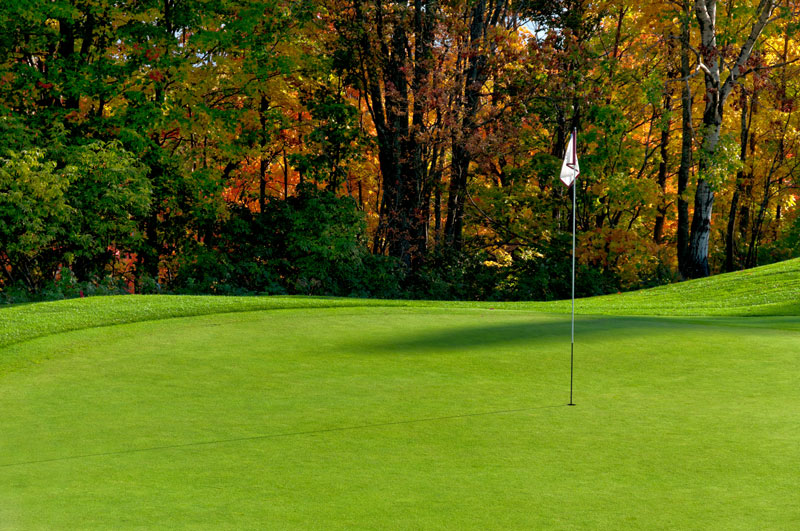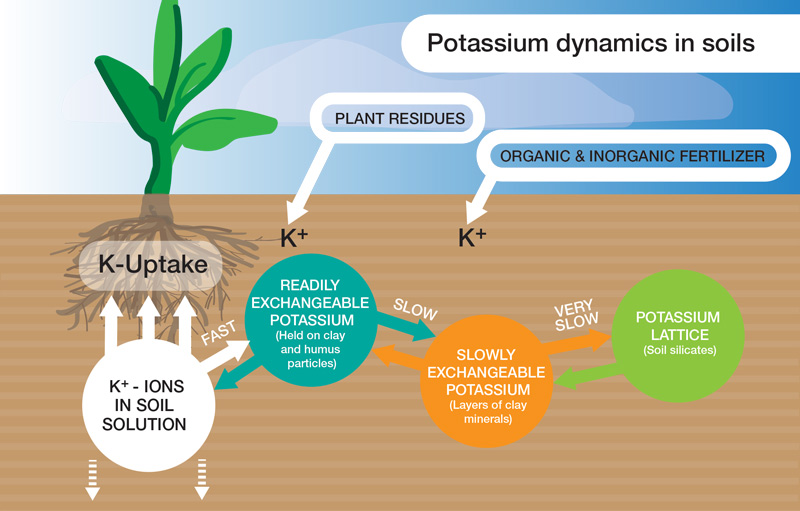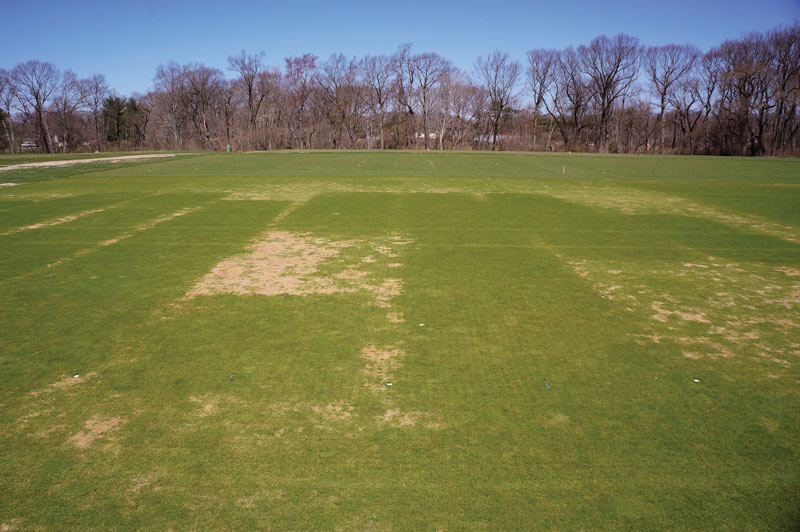
Special K: Potassium and nitrogen are the elements turf requires in the greatest quantities for growth and quality. But is potassium’s perceived role as turf stress mitigator supported by research? Photo by Adobe Stock
It’s a “fact” long held by turfgrass managers — apply potassium (K) in times of stress, be it heat, drought or traffic. There’s actually science behind this idea, as potassium plays a role in cellular turgor, which affects plant cell rigidity. But does adding potassium truly affect turfgrass wear, cold or drought tolerance? Lucky for us, there is some research that examines the effects of K on turfgrass performance in stressed conditions.
Potassium effects on turfgrass wear tolerance
Wear of turfgrass can be separated into two distinct parts — the physical abrasion/tearing of the leaf, and the underlying compaction and consolidation of soil particles due to traffic. Often, these two segments of wear are simply studied together, such as when artificial wear is imposed using a tire-wear simulator.
Such wear was applied to creeping bentgrass putting greens in New York, with treatments that were a combination of nitrogen (N) and K. Two rates of urea N (48 kilograms per hectare once or twice a year; 1 or 2 pounds N per 1,000 square feet per year) and four rates of potassium chloride, or KCl (48 kilograms K per hectare applied 0, 1, 2 or 4 times per year, for totals of 0, 1, 2 or 4 pounds K per 1,000 square feet per year), were applied in June, with additional applied as per treatment in November, May and August.
After about 200 revolutions of tire wear, tolerance of aboveground growth was measured, and this was done every year for four years. By Year 4, the higher N rate had increased wear tolerance, but it did not speed recovery of worn turf. And did the addition of any amount of K affect wear or recovery? It did not. The addition of any rate of potassium did not affect wear tolerance or recovery from wear at any location (1).

The breakdown of potassium in soil. Illustration by Kelly Neis
Similar and later work also had treatments of urea N (49, 147, 245, 343 or 441 kilograms per hectare per year; 1, 3, 5, 7 or 9 pounds per 1,000 square feet) and K (1, 5 or 9 pounds K per 1,000 square feet per year as potassium sulfate) all applied to perennial ryegrass managed at a 1.3-inch (3.2-centimeter) height of cut. In this study, turfgrass wear was implemented with two devices, the first being a differential slip and the second a grooming brush, with both designed to prevent underlying soil compaction. As with the previous cool-season study, the N treatments accounted for almost 95% of the treatment variation due to wear, with wear tolerance decreasing as N increased. So, the most important nutrient for wear tolerance and recovery was nitrogen. Added potassium had little to no effect on wear tolerance and recovery (3).
Editor’s note: Are some pricier nitrogen sources a better value in the long run? Researchers looked into the claim, measuring turf’s responses to 10 N sources and the cost to achieve such responses. Read their findings in Nitrogen fertilizer costs and turfgrass response.
Moving south to a warm-season turfgrass (seashore paspalum) produced the same results. Sand-based putting greens — with 10 yearly applications of N and/or K, with N to total 196 or 392 kilograms per hectare (4 or 8 pounds per 1,000 square feet) and K to total 92 or 392 kilograms per hectare (2 or 8 pounds per 1,000 square feet) — were subjected to artificial wear via rubber-covered slip rollers. Again, higher N increased wear tolerance, while the addition of K provided no enhancement in wear tolerance (6).
Potassium effects on turfgrass cold tolerance
Down in Mississippi, more factorial treatments of N (0, 4.9 and 9.8 grams per square meter; 0, 1 and 2 pounds per 1,000 square feet, as ammonium nitrate) and K (0, 4.9 and 9.8 grams per square meter, as KCl) were applied to Tifgreen hybrid bermudagrass putting greens. One application was made in the second week of October in each year of three consecutive years. Collected data included color, quality, and total nonstructural carbohydrates (TNC) of stolons and rhizomes. All data was collected in fall, prior to dormancy, and in spring, after green-up.
Warm-season turfgrass managers often avoid later-season soluble N applications, thinking that bermudagrass approaching dormancy will not use the N, and that such late-season N could lead to winter damage. That was not observed here, although the lower rate of N was typically sufficient to maintain fall color and improve spring color as well. While TNC did decrease as N increased, the decrease was not significant, nor was winter damage due to the addition of late-season N ever evident.
The addition of K never affected bermudagrass color or levels of TNC. Yes, K did increase in leaf tissue as K fertilization increased, but this increase was never related to color or quality or improved cold tolerance. There was simply no benefit to adding late-season K to Tifgreen hybrid bermudagrass (2).

A study in New Jersey in 2015 showed that potassium does improve cold tolerance, but, critically, it found that the minimum amount of K achieved that benefit, and that applying lots of additional K did not result in enhanced cold tolerance. Photo by Chas Schmid
Moving back north, the folks at Rutgers reported on the effects of potassium on winter injury after an especially cold 2014-2015 winter. In addition to low temperatures, mixed snow and ice had covered the turfed surfaces for over 47 days. A potassium source and rate trial had been installed on an annual bluegrass putting green, and once melting occurred, winter damage was evident (5).
The K source/rate trial consisted of four K sources (KCl, potassium sulfate [K2SO4], potassium carbonate and potassium nitrate), all applied at rates of 1.3, 2.7 or 5.4 pounds K2O per 1,000 square feet per year (1.0, 2.2 or 4.4 pounds K per 1,000 square feet; 49, 107 or 215 kilograms per hectare). The K was applied as a spray solution from May to November as 16 split applications, with those applications made for a total of three years. Once it was evident that there was winter damage, the plots were rated for turf cover injury using a line-intersect method to count the extent of the damage.
In March, plots that had not received any K fertilizer had, on average, 58% turf injury, while those that had received any amount of K had from 2% to 4% damage. By April, plots that received any K had no measurable damage at all (100% recovery), while plots that received zero K still had 32% damage. In this study, the lowest rate of K fertilization was sufficient to provide this protection against winter injury. For reference, plant tissue K and Mehlich-3 soil K in zero-K plots were 1.3% and 56 pounds per acre, respectively, while that from plots receiving K fertilization averaged 2.6% to 3.1% tissue K and 140 to 370 pounds per acre Mehlich-3 extractable K.
As an additional test, samples of annual bluegrass from zero-K and K-fertilized (the KCl 5.4-pounds-K2O-per-1,000-square-feet treatment) plots were removed and moved to the greenhouse for cold hardiness tests. Plants that had been fertilized could withstand lower temperatures, with half killed at 2 F (minus 16 C). In comparison, half of the annual bluegrass plants that were not fertilized with K were killed at the higher temperature of 7 F (minus 14 C) (5).
Plain talk on potassium
So, in four of five studies, fertilization with K did not benefit wear or cold tolerance. In fact, there was never a study in which the addition of K imparted improved traffic or wear tolerance.
The final study, in which K fertilization did improve cold tolerance? It is important to remember that the lowest level of K fertilization was sufficient, and that excess K did not improve cold tolerance to any better degree. The Mehlich-3 K soil test range the authors proposed as a critical soil test level was between 56 and 140 pounds per acre. Within that lower soil test range, a K fertilization recommendation would likely occur (it will vary by soil and state recommendations), so following K fertilizer recommendations would likely supply sufficient K for cold tolerance. Importantly, this work showed that adding lots of additional K served no additional value for improved cold tolerance.
The drought mulligan (the extra sixth paper)
Increasing K in relation to N (varying ratios from 1N:1K to 1N:4K) failed to increase drought resistance for various cultivars of hybrid bermudagrass, seashore paspalum or zoysiagrass (4).
Literature cited
- Carroll, M.J., and A.M. Petrovic. 1991. Wear tolerance of Kentucky bluegrass and creeping bentgrass following nitrogen and potassium application. HortScience 26(7):851-853 (https://doi.org/10.21273/HORTSCI.26.7.851).
- Goatley Jr., J.M., V. Maddox, D.J. Lang and K.K. Crouse. 1994. ‘Tifgreen’ bermudagrass response to late-season application of nitrogen and potassium. Agronomy Journal 86(1):7-10 (https://doi.org/10.2134/agronj1994.00021962008600010002x).
- Hoffman, L., J.S. Ebdon, W.M. Dest and M. DaCosta. 2010. Effects of nitrogen and potassium on wear mechanisms in perennial ryegrass: I. Wear tolerance and recovery. Crop Science 50(1):357-366 (https://doi.org/10.2135/cropsci2008.08.0474).
- Rowland, J.H., J.L. Cisar, G.H. Snyder, J.B. Sartain, A.L. Wright and J.E. Erickson. 2014. Drought resistance of warm-season putting green cultivars on U.S. Golf Association root zones with varied potassium. Agronomy Journal 106(5):1549-1558 (https://doi.org/10.2134/agronj14.0019).
- Schmid, C.J., J.A. Murphy, B.B. Clarke, M. DaCosta and J.S. Ebdon. 2016. Observations on the effect of potassium on winter injury of annual bluegrass in New Jersey in 2015. Crop, Forage & Turfgrass Management 2(1):1-4 (https://doi.org/10.2134/cftm2015.0170).
- Trenholm, L.E., R.N. Carrow and R.R. Duncan. 2001. Wear tolerance, growth, and quality of seashore paspalum in response to nitrogen and potassium. HortScience 36(4):780-783 (https://doi.org/10.21273/HORTSCI.36.4.780).
Beth Guertal is the Rowe Professor of Soil Fertility in the Department of Crop, Soil and Environmental Sciences at Auburn University in Auburn, Ala., and past president of the Crop Science Society of America. She is a 23-year member of GCSAA.